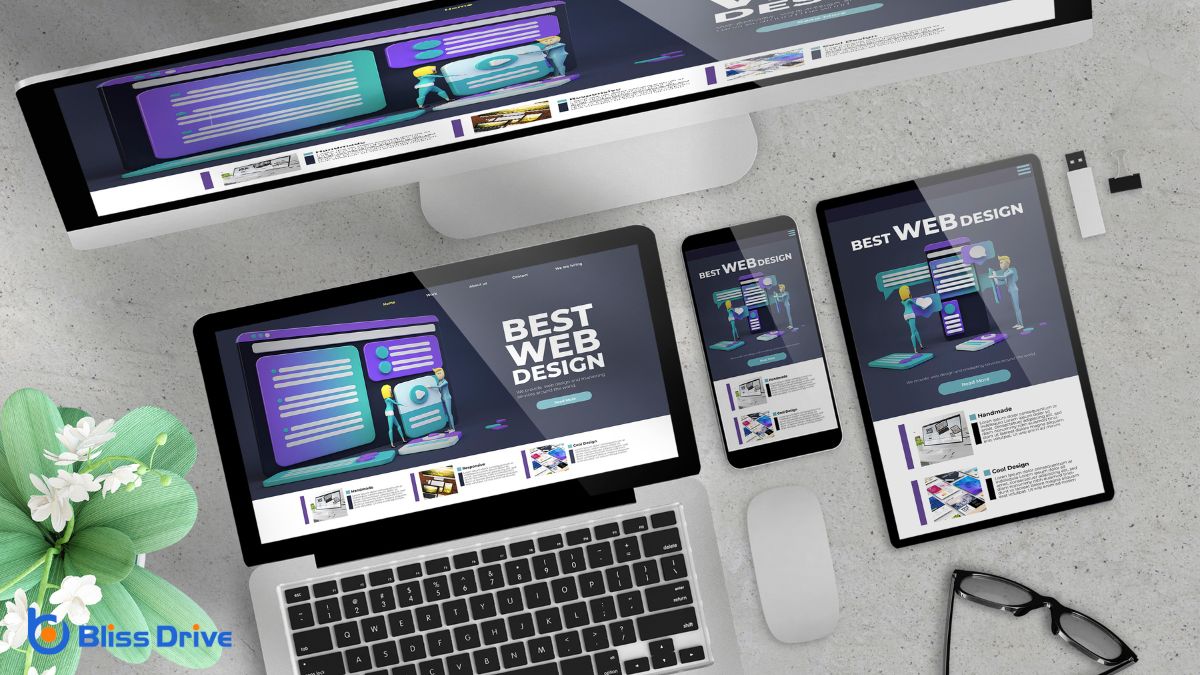Learn More About Us

When you're designing a website, speed should be a top priority. The elements you choose, from images to layout, directly impact how fast your site loads. A cluttered design or large files can slow everything down, frustrating users and affecting search rankingsThe position at which a website appears in the SERP.. By understanding how design choices affect speed, you can create a more efficient site. Curious about which design aspects make the biggest difference in performance? Let's explore.

When you're designing a website, it's vital to contemplate how graphics and images can affect load times. Large, unoptimized images can greatly slow down your site, frustrating users and potentially driving them away.
You should prioritize compressing images without compromising quality. Tools like TinyPNG or ImageOptim can help reduce file sizes efficiently. It's also important to choose the right file formats; for example, use JPEGs for photos and PNGs for graphics with transparency.
Implementing responsive images guarantees your site loads different sizes based on the user’s device, optimizing performance. Remember, a faster-loading site improves user experience and boosts search engine rankings.
Keeping graphics in check is key to maintaining a sleek, speedy website that retains visitors and enhances engagementThe interactions that users have with a brand’s content on social media..
When you're designing a website, consider how multimedia elements like images, videos, and audio files affect performance.
Optimizing images is essential for guaranteeing quick load times, while managing video content can prevent lagging issues.
Don't forget that audio files also play a role in how fast your site runs, so make sure they're properly formatted and compressed.
To guarantee your website runs smoothly and efficiently, it’s crucial to focus on image optimization. Images notably impact load times, and optimizing them can enhance user experience.
Here’s how you can achieve this:
Although videos can enrich the user experience by delivering engaging content, they often present significant challenges for website performance. When you include videos, they can slow down your site due to large file sizes, affecting load time and user satisfaction.
Slow loading videos might frustrate users and leadA potential customer referred by an affiliate who has shown interest in the product or service but h... to higher bounce rates. It’s essential to optimize video content by compressing files and choosing the right formats. Additionally, consider using lazy loading, which defers loading videos until they’re needed. This approach helps maintain a smooth browsing experience.
Hosting videos on external platforms like YouTube or Vimeo can also reduce server load. By managing video content effectively, you guarantee your site remains fast and user-friendly, creating a better overall experience.
Just as videos can enhance or hinder your site's performance, audio files also play a significant role in shaping user experience. When you include audio, you should consider several factors to optimize performance.
Here’s a list to help you:
When you design a website, the way you arrange elements can greatly impact its loading speed.
If your page is overloaded with visual elements, it can slow down performance and frustrate users.
To keep your site quick and efficient, focus on a clean, simple layout that prioritizes essential content.
The complexity of your website’s layout directly impacts its loading speed. When you design a site, pay attention to how you arrange elements on each page. A cluttered or poorly organized layout can slow down load times.
Here’s how to optimize for speed:
Building on the importance of element arrangement, let's explore how visual element overload can affect your website's speed. When your site is packed with too many images, videos, or animations, it can slow down the loading timeThe time it takes for a webpage to fully load, affecting user experience and conversion rates. considerably.
Every element needs to be downloaded by the user's browser, so more elements mean more loading time. This can frustrate visitors and drive them away before they even see what you have to offerThe specific product or service being promoted by affiliates..
To keep your site fast, focus on simplicity. Prioritize essential elements and optimize images and videos to reduce their file size.
Consider using lazy loading, which loads images only when they're needed. By managing your visual contentImages, videos, and other visual elements used to engage users and improve conversion rates. carefully, you guarantee a quicker, more pleasant experience for your users, keeping them engaged and satisfied.
Although often overlooked, fonts and typography choices greatly impact a website's loading speed.
When you select fonts, you're affecting how quickly users can access your site. Here’s how to make smart choices:
While coding may seem like a behind-the-scenes task, it directly influences your website's speed. Efficient coding practices minimize load times and improve user experience.
Start by optimizing HTML, CSS, and JavaScript. Minify these files to reduce size and eliminate unnecessary characters. Use asynchronous loading for JavaScript so it doesn't block other content from loading.
Leverage browser caching to store resources locally, reducing server requests. Simplify your code by eliminating redundant scripts and combining files when possible.
Always keep your code clean and organized for easier maintenance and quicker troubleshooting.
Consider using a Content Delivery Network (CDN)A system of distributed servers that deliver content to users based on their geographic location. to distribute content across global servers, speeding up data delivery.
Efficient coding practices set the stage for a fast website, but it's equally important to confirm that your site performs well across all devices.
Responsive designA web design approach that makes web pages render well on a variety of devices and window or screen ... isn't just about aesthetics; it directly impacts performance. When you design responsively, you ascertain that your site is both user-friendly and fast-loading, regardless of the device or screen size.
Here are four reasons why responsive design is essential for performance:
To enhance your website's speed, minimizing HTTP requests is essential. Each element on your website, like images, scripts, and stylesheets, triggers an HTTP request. The more requests, the slower your site loads.
You can reduce these by combining files, such as merging CSS and JavaScript into fewer files. This consolidation decreases the number of requests the browser has to make.
Another effective strategy is to optimize images. Compress them to a smaller size without losing quality, which speeds up load times.
Additionally, consider using CSS sprites—one large image containing multiple graphics accessed with coordinates. This technique reduces the number of individual image requests.
Although plugins and third-party scripts can add valuable functionality to your website, they often come with a high cost. Each plugin or script may introduce additional requests, increase the page size, or cause conflicts, ultimately slowing down your site.
Here’s how they affect speed:

When enhancing your mobile site’s performance, it's crucial to recognize that users demand fast and seamless experiences.
Begin by minimizing your site's code. Remove unnecessary CSS and JavaScript, and compress images to reduce load times. Use responsive design to adapt content to various screen sizes.
Implement browser caching so frequent visitors don't have to reload unchanged resources. Leverage Content Delivery Networks (CDNs) to distribute assets closer to users, speeding up access time.
Prioritize above-the-fold content, ensuring it loads first, to keep users engaged. Test your site with tools like Google PageSpeed Insights to identify bottlenecks.
Finally, regularly update and audit your site to maintain peak performance. Remember, a swift mobile experience keeps users satisfied and engaged.
To boost your website's speed, focus on simplifying your design. Optimize images and graphics to prevent slow load times. Use efficient coding practices like minifying files and asynchronous loading to enhance performance. Pay attention to layout complexity, fonts, and multimedia elements, as they can impact speed. Prioritize responsive design and minimize HTTP requests for a smoother user experience. Also, keep an eye on plugins and third-party scripts, as they can slow down your site.
